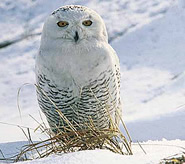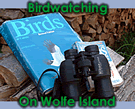Snowy Owl

Snowy Owl (Nyctea scandiaca)
- Length: 51 to 69 cm Wingspan: 137 to 152 cm
- Weight 1.59 to 2 kg
- Large owl without ear tufts.
- White plumage with some dark barrings.
- Large, round head, yellow eyes and beak, claws black.
- Females larger and more heavily barred.
- Juveniles are uniformly brown with scattered white tips of down.
The snowy owl breeds in the arctic regions of Europe and North America. They feed primarily on lemmings and other small rodents. Unlike other owls snowy owls are diurnal.
Snowy owls frequently make a winter home on Wolfe Island. Observers this winter have reported sightings along the 4th and 7th line roads. Birdwatchers are advised to explore the many country roads on the western side of the island paying careful attention to the farmland and open meadows of that side of the island.
Snowy Owls are about the size of a Great Horned Owl but are different in that they will hunt during the day and that they have two different colors of plumage depending upon the season. The Snowy Owl has a rounded head, yellow eyes and black bill. The feet are heavily feathered. A distinctive white Owl, their overall plumage is variably barred or speckled with thin, black, horizontal bars or spots. Females and juveniles are more heavily marked than males - adult males may be almost pure white, although they have up to three tail bands. Adult females are distinctly barred throughout, and have from four to six tail bands. Immatures are very heavily barred throughout, and dark spotting may codominate or dominate the overall plumage. Intensity of dark spotting varies with the sex of the immatures, females being the darkest. Juveniles are uniformly brown with scattered white tips of down.
Snowy Owls have a direct, strong, and steady flight with deliberate, powerful downstrokes and quick upstrokes. They make short flights, close to the ground, from perch to perch, and usually perches on the ground or a low post.

